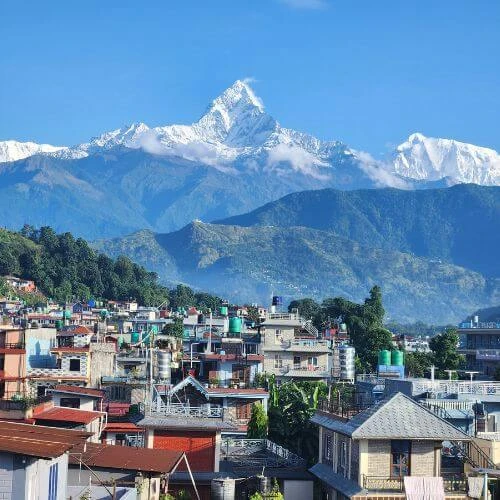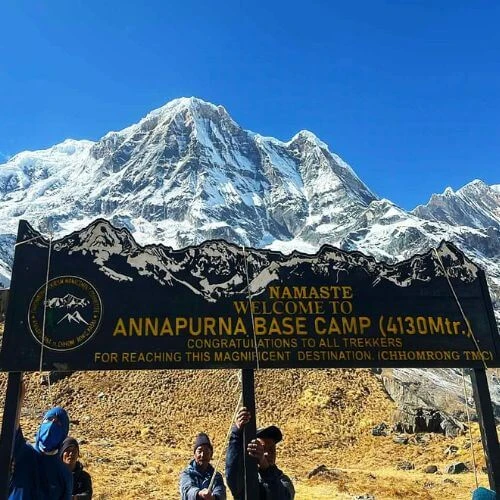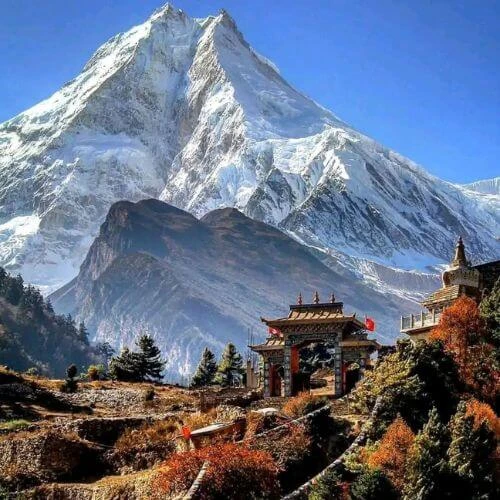Is Nepal Safe for Solo Travel?
Several important factors have contributed to Nepal's growing image as a safe destination for solo travelers and solo female travelers alike. First and foremost, there is the country's friendly culture. People in Nepal are warm and welcoming, especially to tourists. In areas frequently visited by tourists and on the trekking routes, people become so used to foreigners that they are always ready to help and are polite towards them.
Besides, the rate of crime is relatively low in Nepal, particularly in areas that tourists visit. While petty crimes, such as pickpocketing, might occur within the confines of crowded markets, violent crimes against travelers do not happen often. Tourist police stations in Kathmandu and Pokhara, among other trekking hotspots, provide support for and further enrich the feeling of safety among solo travelers.
Another big plus is that Nepal offers infrastructural trekking, where the pathways are well-marked and, at each stop, a variety of teahouses and lodges are available for safe lodging. Solo trekkers can find highly reputable guides or join trekking groups for an added layer of security. Reliability and safety in the trekking experience come from prioritizing local guides and agencies for the safety of their clients.
The whole Nepalese tourism system is well-organized, systematically focusing on issues of travelers' safety. Most tourism businesses involve experience in ensuring the safety of foreign visitors, hotels, trekking service agencies to transportation services. Besides, in the major trekking areas, emergency services are well coordinated for prompt action in case of any incident or accident.

Is Nepal Safe for Solo Female Travellers?
Nepal is considered one of the safest destinations for solo female travelers. Many solo female travelers in Nepal state the fact that they have never felt uncomfortable or unsafe while seeing the country on their own. The Nepali people are very welcoming, and it is common to see women traveling solo in Nepal. Generally, the culture is respectful and hospitable, with established networks within tourist areas.
It is, however, always a good thing to be prepared and respectful of local culture. Following are some of the tips to ensure a safe and enjoyable journey when you are traveling solo in Nepal as a female traveler.
- Dress modestly concerning local culture.
- Take only registered taxis and transportation, especially at night.
- Pre-book your accommodation in a good hotel.
- Be more aware of your personal belongings, particularly in Thamel, Kathmandu, which is a tourist area.
- Go trekking only through registered guides/companies and not alone.
- Have emergency contact numbers handy.
Places or situations that call for caution include isolated areas at night, public transportation during festival seasons, trekking routes that are off the beaten path, and some border areas. Staying informed and prepared can help ensure a safe and smooth travel experience.
How to get around in Nepal?
First-time solo travelers may find it difficult to navigate in Nepal due to confusing roads and chaotic public transportation. However, much of this trouble can be minimized by having the right information and planning accordingly. Here's an extensively detailed guide for solo travelers on how to get around in Nepal.
Internal Flights
Internal flights are pretty handy for solo travelers in Nepal who look forward to covering long distances in the shortest time. Most of the major operators provide services to connect major cities like Kathmandu, Pokhara, and Lukla, among others. Most of them can be booked directly from their websites or through local travel agents. Keep in mind that delays and cancellations because of bad weather are common, especially in the mountains. The flight prices usually range from $100 to $200, and this is a decent option as it saves time for solo travelers in Nepal.
Tourist Buses
Tourist buses are the most comfortable long-distance travel options by road. The tourist buses operate on the main routes connecting Kathmandu with the centers of tourism, such as Pokhara and Chitwan. Companies like Greenline operate on some routes and often provide air conditioning. You can book tickets one day in advance from your hotel or local travel agencies for $15 to $25 depending on how far you will be traveling. These buses generally include lunch stops and bathroom breaks along the route.

Local Buses
If you want to get around Nepal by yourself with very few bucks, take a local bus. The comfort will be pretty basic. These buses are available everywhere, and no advance bookings are required. The shorter trips can cost around $1 to $5 and that's very good to see the local life during your solo travel in Nepal. For an easier trip, it is better to take a seat near the front, travel during daylight, and keep valuables close. Confirm the fare beforehand.
Taxis
Taxis are available everywhere in towns and cities and provide a much more flexible way of traveling for the solo traveler to Nepal. Agree the fare with the driver before you start your journey since not all taxis in Nepal have meters. An average typical ride will range from $2 to $5. For further security, ask your hotel what the normal price that you should pay is, and where possible take a metered taxi, especially in Kathmandu. It is also helpful to write down the name of your destination in Nepali if you are a solo traveler with a problem with language barriers.
Rickshaws and Cycle Rickshaws
Rickshaws and cycle rickshaws are available everywhere, such as in Thamel, and ply their trade by offering a very inexpensive way of traveling short distances. Fares are about $1-$2, but you should always bargain. As with taxis, agree on the price beforehand to avoid complications. Solo travelers sightseeing in Nepal find this mode of travel very convenient and local.
Walking
As a solo traveler, walking is generally the best way to see Nepal's cities and villages. Most of the towns are quite friendly for pedestrians, with nice streets to explore on foot. Be sure to download offline maps like Maps.me, which is quite good in Nepal, since GPS doesn't always work well in these areas. Also, bring a torch because of the occasional power cuts on evening walks. Day strolling is also a great way to see the local atmosphere by solo travelers in Nepal.
Ride-Sharing Apps
For solo travelers in Nepal, technology can make getting around far easier. Ride-sharing apps such as Pathao, in Drive, and Tootle offer a very efficient way of getting around cities, while Maps.me offline navigation is a must for solo travel in Nepal. Local bus route apps, such as Nepal Yatayat, are also helpful to get around on public transportation. Also, some of the Nepal travel groups on Facebook will give good advice to other travelers.
Safety tips to get around for Solo Travelers in Nepal
Pre-Trip Preparation
Before heading to Nepal for a solo trip, you must get ready with all your important documents. Carry a number of copies of your passport and visa, and save digital copies in cloud storage. Bring some emergency contact numbers and invest in comprehensive travel insurance, especially if you will be trekking through areas over 4,000 meters high. This could be very important and assure extra protection if you register with your embassy in Kathmandu.
Preparation for Health
Have the necessary vaccinations before traveling to Nepal, such as Hepatitis A and Typhoid. Bring basic medical supplies, including medication for altitude sickness if applicable for areas you will be trekking. Find out which hospitals are reliable in towns, and always carry a card mentioning your blood group in case of an emergency.

Safety in Transport
Local Transportation
Always use registered black number plate taxis. Do always bargain for the price before starting the journey and, if possible, try to avoid highways at night. Do use Tourist buses for inter-city travel. Book mountain flights from well-reputed companies.
Walking Safety
Be careful while walking, especially in crowded areas including Thamel. Try not to walk alone in the dark. Stick to well-lit streets that have people around. The power cuts are frequent in Nepal, so it would be advisable not to carry valuables and to carry a small torch.
Trekking Safety
Never trek alone; make the concerned authorities aware of your route by registering your route with the Trekkers' Information Management System. In addition, the hiring of licensed guides through registered trekking companies is permitted. Always check the weather before you start off every morning. Stick to designated trails only and carry satellite devices in case of emergencies for locations where communication is not available.
Safety around the Temple and Religious site
While visiting temples and religious sites, please make sure your valuables are secured especially during crowded events. Be also aware that in some temple areas, there are monkeys and these can get aggressive. Respect local photography customs and avoid being alone in these areas anytime, especially when it's deserted at dawn and dusk.
Safety in Communication
Keep connected, and it is important for your safety. Buy a local SIM card; you need to provide a passport copy to purchase it. Store some important contacts in your phone: police-100, tourist police number +977-1-4247041, ambulance services-102. Download offline maps, just in case you run out of your data pack. Bring a power bank as well to keep extra battery life. You can learn some basic Nepali words for emergencies.
Daily Safety Tips
As a solo traveler, trust your instincts and stay aware of your surroundings. Keep emergency numbers accessible and maintain regular contact with family or friends. Whenever possible, join other travelers for added safety, and stay updated on local news. Carry a day bag with your essentials and keep copies of important documents in both physical and digital formats.

When should I Visit Nepal?
When planning a solo trip to Nepal, it largely depends on what activities one wants to do. Each of the seasons offers something special, from trekking in the Himalayas down to unique cultural activities.
The time from October to November is the best time to trek in Nepal for solo travelers. It is the time when the skies are clear, with moderate temperatures and breathtaking sceneries of mountain peaks. The popular trails such as Everest Base Camp and the Annapurna Circuit are at their best. This is the busiest time, and you will meet many trekkers along the way. Since the weather conditions can be predicted, the trekkers are much safer. But this also happens to be the peak season, so one needs to book in advance for the hostels.
If you prefer a quieter experience, March to April is another great option for solo trekking in nepal. The temperatures are warm, and flowers will bloom to add color to the landscape, particularly the rhododendrons. The trails are not so crowded, yet there is still an excellent possibility to meet others along the way. The views are clear though not as clear during the autumn season in Nepal, but, of course, this period is great for photography with all the blooming flowers.
In general tourism, the best time to visit Nepal is from September to November. The weather remains pleasant while major festivals like Dashain and Tihar bring the culture alive. It is an appropriate time to make roundups in the cultural sites, and one gets to visit other interesting places like Chitwan National Park.
However, It is best to avoid June to August, as the monsoon season in Nepal brings heavy rain and poor visibility. December to February can get very cold, especially at high altitudes; however, trekking in low altitude and rain shadow areas is still possible.
Is a Guide compulsory for Trekking in Nepal?
As of April 2023, the trekking policies of Nepal, due to the Nepal solo travel ban, do not allow solo trekking in the country's national parks and conservation areas. It has been approved to improve safety and make possible emergency responses easier in remote areas. In fact, any solo trekkers, trekking alone in the remote areas of Nepal should preferably have at least one local guide accompanying them. Solo trekkers can get a TIMS card only through a registered travel agency or with the assistance of a local guide. Ghorepani Poon Hill, Mohare Danda, and Pikey Peak routes permit independent trekking; however, guides are recommended for safety reasons.
Your guide has to be registered with the NTB and has to have a license for a trekking guide. He/she also needs to be employed by a licensed trekking agency. Besides, trekkers will need permits for national parks or conservation areas they pass through, and sometimes additional permits for special routes, in addition to the TIMS Card.
More than a matter of legal compliance, hiring a guide offers substantial local knowledge, navigation assistance, and awareness of weather conditions contributing to safety on the trek. They also help bridge language gaps in communication and provide valuable insight into local culture. Guides attend to all the necessary logistics: handling permits, making accommodations, and negotiating local prices, which help make the trek smoother and more enjoyable.
Other than that, the guides are also trained in handling emergencies such as evacuation, first aid, and communication with local authorities. The trekkers too, are expected to plan for their travel through insurance, emergency contact information, and medical information and by listening to instructions given by the guide along the trek.
What are the Popular Treks for Solo Travellers in Nepal?
Everest Base Camp Trek
Everest Base Camp Trek is a well-known trek in the world, allowing an unforgettable journey to the base of the world's highest mountain, Mount Everest. Being on a solo journey, one would find the breathtaking views of Everest, Nuptse, and Lhotse while walking via Sherpa villages like Namche Bazaar and Tengboche. The trail is well-marked, and tea houses are available along the way, making it easy to meet other trekkers and feel safe. However, keep in mind that you’re required to trek with a guide, as solo trekking is banned in Nepal. The trek usually takes 12-14 days and is considered moderately challenging, making it suitable for those seeking both adventure and breathtaking scenery.

Ghorepani Poon Hill Trek
Ghorepani Poon Hill Trek is a short and easy trek. It is one of the most popular trekking routes among solo travelers in Nepal, offering spectacular sunrise views over the Annapurna and Dhaulagiri ranges. It takes one through gorgeous rhododendron forests and charming villages. This usually takes 4 to 5 days to complete, just perfect for giving a solo adventurer the taste of trekking in Nepal without investing the time required for longer treks.
Annapurna Circuit Trek
The Annapurna Circuit is famous for its diverse landscapes, from green forests to high mountain deserts. Solo travelers find this trek easy to navigate because of its well-marked paths and wide range of tea houses. Along the way, you'll pass through villages with rich Hindu and Tibetan influences, making it a cultural experience as well. The Annapurna Circuit is truly one of the most popular treks for solo travelers in Nepal, offering a perfect mix of adventure, scenery, and local culture.
Langtang Valley Trek
The Langtang Valley Trek offers a quieter and more peaceful experience making it as the best solo trek in Nepal . Solo travelers appreciate the serene atmosphere and fewer crowds. The trail takes you through lush forests and traditional Tamang villages, offering incredible views of the Langtang range. Since it’s close to Kathmandu, this trek is convenient for those with limited time. Despite being less crowded, there are still enough tea houses to ensure safety and comfort.
Mardi Himal trek
The Mardi Himal Trek is a newly opened off-the-beaten path in nepal, offering stunning views of Annapurna South, Hiunchuli, and Machapuchare. Solo travelers who want a more remote and quieter experience love this trek. The route takes you through dense forests and high ridges, with tea houses along the way for accommodation. This trek is perfect for solo adventurers looking for something a bit less traveled destination path but still safe and enjoyable.

Frequently Asked Questions
Is it safe for a foreigner to travel alone in Kathmandu?
Yes, many foreigners travel alone in Kathmandu and generally find it safe. However, it's advisable to stay aware of your surroundings and take common safety precautions.
Where can I solo travel in Nepal?
There are several best places for solo travel in Nepal, some of them include
- Pokhara: Known for its stunning lakes and trekking opportunities.
- Chitwan National Park: Great for wildlife viewing and safaris.
- Lumbini: The birthplace of Buddha, offering a peaceful environment.
- Langtang Valley: Ideal for trekking and experiencing local culture.
What are the dont’s in Kathmandu?
- It’s best to avoid pointing your feet at people or religious objects, as this can be seen as disrespectful.
- Try not to engage in discussions about sensitive topics like politics or religion, as they might make some people uncomfortable.
- Be mindful when taking photos; it’s a good idea to refrain from taking pictures in restricted areas, especially around military or government buildings.
- Wearing revealing clothing, particularly at religious sites, is best avoided to show respect for local customs.
Is Thamel safe at Night?
Thamel is generally safe at night due to its tourist-friendly atmosphere, but it's still wise to stay in well-lit areas and avoid wandering alone late at night.
Is Kathmandu safe for solo females?
Kathmandu is generally safe for solo female travelers, but it's essential to take precautions. Dressing modestly, avoiding isolated areas at night, and staying aware of surroundings are recommended.



 based on 15 reviews
based on 15 reviews









